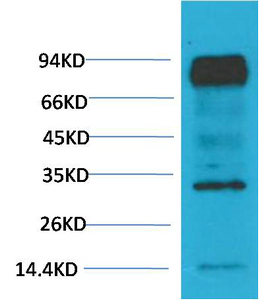Total HIF-1β Cell-Based Colorimetric ELISA Kit
- Catalog No.:KA3574C
- Applications:ELISA
- Reactivity:Human;Mouse;Rat
- Gene Name:
- ARNT
- Human Gene Id:
- 405
- Human Swiss Prot No:
- P27540
- Mouse Swiss Prot No:
- P53762
- Rat Swiss Prot No:
- P41739
- Storage Stability:
- 2-8°C/6 months
- Other Name:
- Aryl hydrocarbon receptor nuclear translocator (ARNT protein) (Class E basic helix-loop-helix protein 2) (bHLHe2) (Dioxin receptor, nuclear translocator) (Hypoxia-inducible factor 1-beta) (HIF-1-beta) (HIF1-beta)
- Detection Method:
- Colorimetric
- Background:
- function:Required for activity of the Ah (dioxin) receptor. This protein is required for the ligand-binding subunit to translocate from the cytosol to the nucleus after ligand binding. The complex then initiates transcription of genes involved in the activation of PAH procarcinogens. The heterodimer with HIF1A or EPAS1/HIF2A functions as a transcriptional regulator of the adaptive response to hypoxia.,similarity:Contains 1 basic helix-loop-helix (bHLH) domain.,similarity:Contains 1 PAC (PAS-associated C-terminal) domain.,similarity:Contains 2 PAS (PER-ARNT-SIM) domains.,subunit:Efficient DNA binding requires dimerization with another bHLH protein. Forms a heterodimer with AHR, AHRR, HIF1A and EPAS1/HIF2A as well as with other bHLH proteins. Interacts with TACC3 (By similarity). Interacts with NOCA7.,
- Function:
- response to hypoxia, in utero embryonic development, regulation of cytokine production, positive regulation of cytokine production, placenta development, embryonic placenta development, regulation of endothelial cell proliferation, positive regulation of endothelial cell proliferation, regulation of carbohydrate metabolic process,regulation of glycolysis, transcription, transcription, DNA-dependent, regulation of transcription, DNA-dependent,regulation of transcription from RNA polymerase II promoter, transcription from RNA polymerase II promoter, response to oxidative stress, positive regulation of cell proliferation, mRNA transcription, embryonic development ending in birth or egg hatching, positive regulation of biosynthetic process, regulation of catabolic process, positive regulation of catabolic process, positive regulation of signal transduction, positive regulation of macromolecu
- Subcellular Location:
- Nucleus.
- June 19-2018
- WESTERN IMMUNOBLOTTING PROTOCOL
- June 19-2018
- IMMUNOHISTOCHEMISTRY-PARAFFIN PROTOCOL
- June 19-2018
- IMMUNOFLUORESCENCE PROTOCOL
- September 08-2020
- FLOW-CYTOMEYRT-PROTOCOL
- May 20-2022
- Cell-Based ELISA│解您多样本WB检测之困扰
- July 13-2018
- CELL-BASED-ELISA-PROTOCOL-FOR-ACETYL-PROTEIN
- July 13-2018
- CELL-BASED-ELISA-PROTOCOL-FOR-PHOSPHO-PROTEIN
- July 13-2018
- Antibody-FAQs

